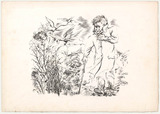Richard Ziegler: We make History (1941)
Richard Ziegler: We make History (1941)
Das Gesicht des Dritten Reiches ist hingeworfen in zwei Zügen: Feigheit mit Energie. So ist es heraufgekommen, ohne Kampf, durch Verrat. So besteht es, treulos, lügenhaft, ohne einen Anflug von Echtheit, aber versteift in den fanatischen Entschluss, sich selbst zu erhalten.
[The face of the Third Reich is best summed up by two characteristics: cowardice and energy. It arose through treachery, and not a struggle. And so there it is - disloyal, deceitful, with no trace of authenticity, but hardened in its fanatical resolve to sustain itself. (ed. trans.)]
Heinrich Mann, The Face of the Third Reich, c. 1934
While in exile in Yugoslavia and England, the painter and graphic artist Richard Ziegler found an outlet for his aesthetic expression in caricature. On the island of Korcula he created series of anti-Nazi caricatures with titles like Führer sehen Dich an and Blut und Boden between 1934 and 1936. When Ziegler was exiled in England after the outbreak of the Second World War in 1940, the London publisher Allen & Unwin released the Führer sehen Dich an series as a book under the title We make History by Robert Ziller. Ziegler worked under this pseudonym as a political cartoonist for newspapers.
In 1941 a licensed edition of We make History was published by Bradford and Dickens, London. The book was also published in Dutch, Russian, Serbian and Danish translations.
The expressiveness of Ziegler's caricatures in We make History derived from his exaggerated and striking portraits of Hitler, Goering, Goebbels and other Nazis. The cartoonist also juxtaposed the portraits with quotes that contradicted the self-image and standing of his subjects. Interleaved with the cartoons were drawings of victims - severed heads, hanging corpses, the wives and children left behind, a drawing of Theodor Lessing who had been murdered in 1933.
Führer sehen Dich an, including poems by Martin Beheim-Schwarzenbach, was published for the first time in Germany by Georg Heintz in 1975.




